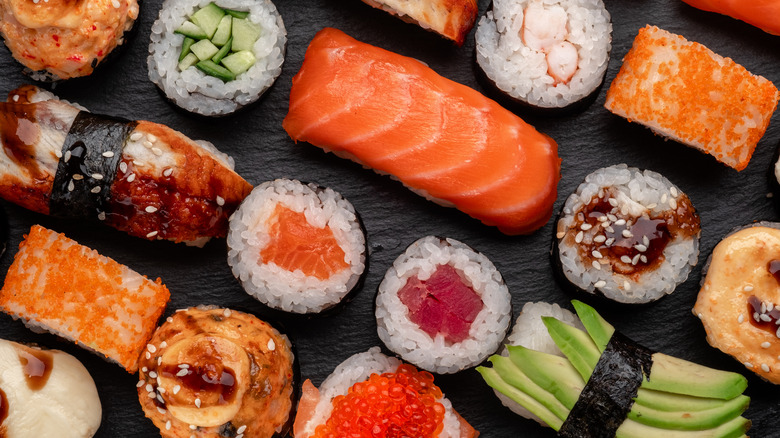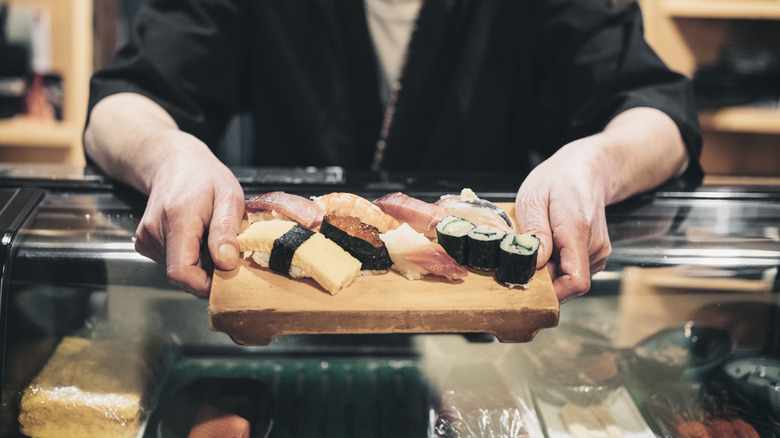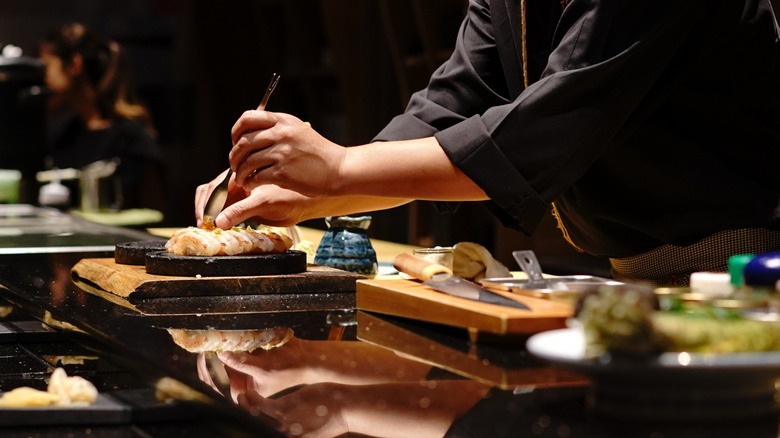The Sushi Bar Etiquette To Know For The Freshest Meal
When it comes to dining at a sushi bar, there are certain etiquette guidelines that are worth following not only to enjoy the pinkest salmon or butteriest tuna they've got on hand, but to show respect for the traditions surrounding this beloved cuisine as well. Whether you're a sushi aficionado or a first-timer, heading to a Michelin-starred omakase (a restaurant where the chef selects dishes for you) or dining at your local joint, understanding the commandments of sushi bar etiquette can mean the difference between an outstanding experience and leaving the chef — and yourself — unsatisfied.
Dining at a sushi bar is more than just getting to savor delicately sweet unagi or creamy yellowtail (aka hamachi) sashimi; it is a reflection of Japanese culture, in which etiquette is deeply rooted. The experience provides an insight into the significance of Japanese tradition, not only with etiquette but with the art of sushi making — a meticulous process that requires years of training and expertise. Sushi bar dining also emphasizes the concept of "omotenashi," which translates to "hospitality" in English. This idea centers around the host's dedication to ensuring the guest's utmost comfort and enjoyment.
From warm greetings to personalized recommendations, every aspect of the sushi bar experience is designed to provide a memorable dining journey. Being as respectful as you can in return allows the design of the sushi experience to come full circle and is the only way to guarantee a belly full of the freshest fish.
How to earn the freshest fish
When entering a sushi bar, it is customary to greet the sushi chef and their team once you receive their warm "Irasshaimase" (meaning "welcome") to acknowledge everyone's presence. Be sure to thank them as well when you leave, making eye contact with the sushi chef if you can.
When it comes to enjoying the sushi itself, start with lighter options and progress to stronger flavors. You can go the omakase route, which simply means allowing the chef to decide for you, as their recommendations possess extensive knowledge about the best and freshest ingredients — which is why you came! Inquire about that day's fish with the sushi chef: What's the freshest? What do they recommend? Quick yet thoughtful questions prove a genuine interest in sushi, and it's a practice that's likely to deliver the freshest fish you can enjoy there anyway — win-win.
While chopsticks are non-negotiable for hot food items, sashimi, and non-sushi dishes, they are not necessary for sushi itself. Japanese guests are accustomed to using their fingers to enjoy freshly prepared sushi. However, if chopsticks are your preferred method, then you need to follow proper chopstick etiquette to avoid insulting the establishment. Don't cross your chopsticks or stick them vertically into your food, as these actions traditionally symbolize death in China and, consequentially in Japan, and are considered disrespectful while dining. Instead, rest them on the chopstick holder or a designated plate when not in use. Proper use of the tools shows your commitment and respect for the experience and ensures a hearty welcome when you return for more super-fresh sushi.
Get friendly with the itamae
The itamae, or master sushi chef, deserves the utmost respect. Avoid engaging in loud conversations or disruptive behavior that may disturb the chef or other diners when you're sitting at the bar. Sitting at the bar offers a unique opportunity to witness the chef's craftsmanship up close, so it is essential to create a serene atmosphere for everyone's enjoyment. Don't ask the itamae for your check, only ask your server, according to David Lowry's "The Connoisseur's Guide to Sushi: Everything You Need To Know About Sushi." Again, respectfulness is key when it comes to earning the freshest fish available with every visit.
Lastly, sushi is typically enjoyed in one full bite in order to fully appreciate the harmony of flavors. Use soy sauce sparingly and dip the fish side of the sushi, not the rice, to avoid overpowering the delicate balance of flavors. In the same vein, it's best to avoid adding additional condiments like wasabi or ginger unless specifically instructed to do so. Ginger is typically served as a palate cleanser between different types of sushi, and the itamae will have already applied the palate-perfect amount of wasabi to the sushi itself.
By following a couple of etiquette guidelines, you can not only fully immerse yourself in the art of sushi, but demonstrate respect for the rich heritage behind it — and get to truly enjoy the freshest fish the establishment has to offer.



